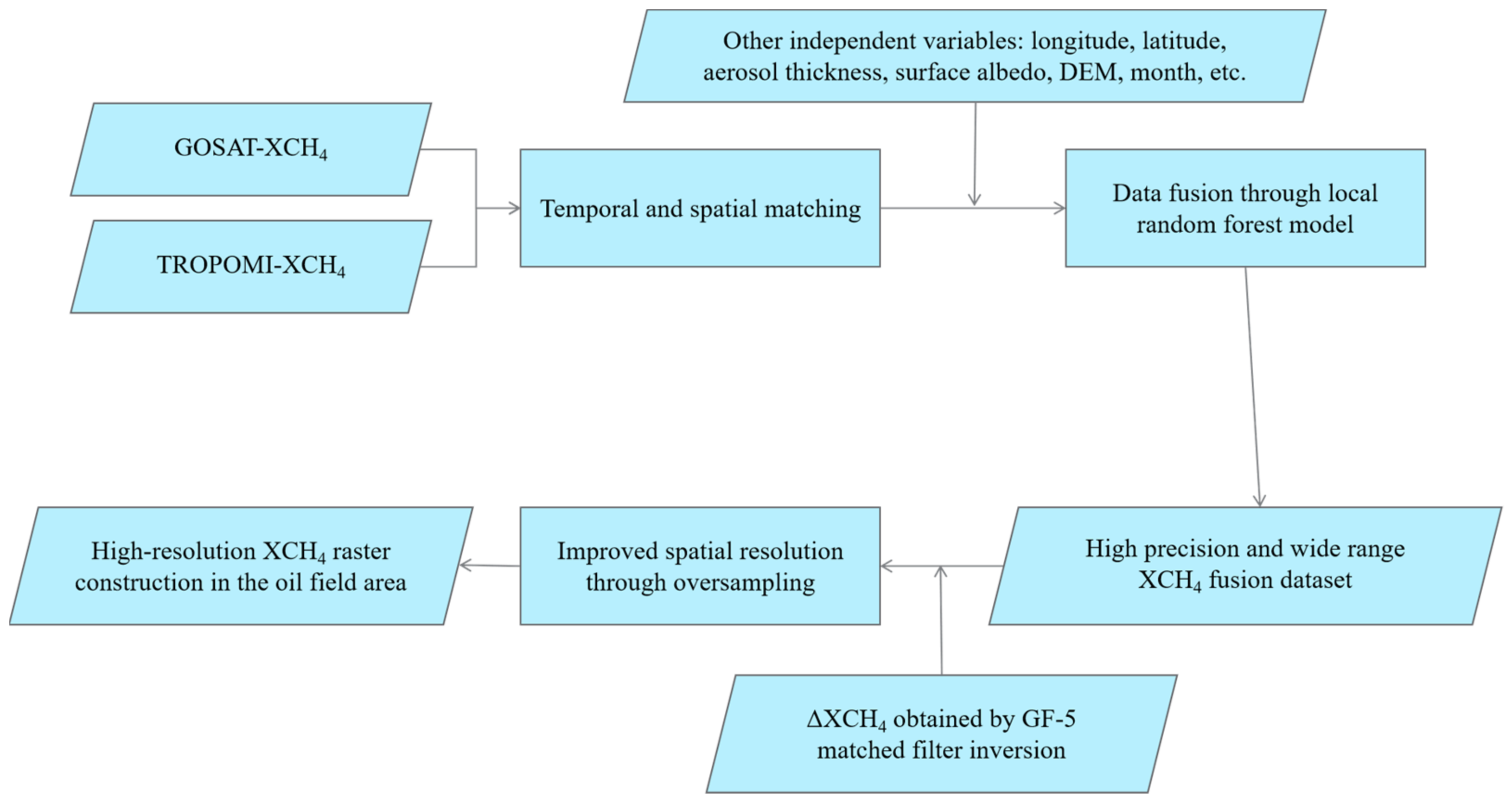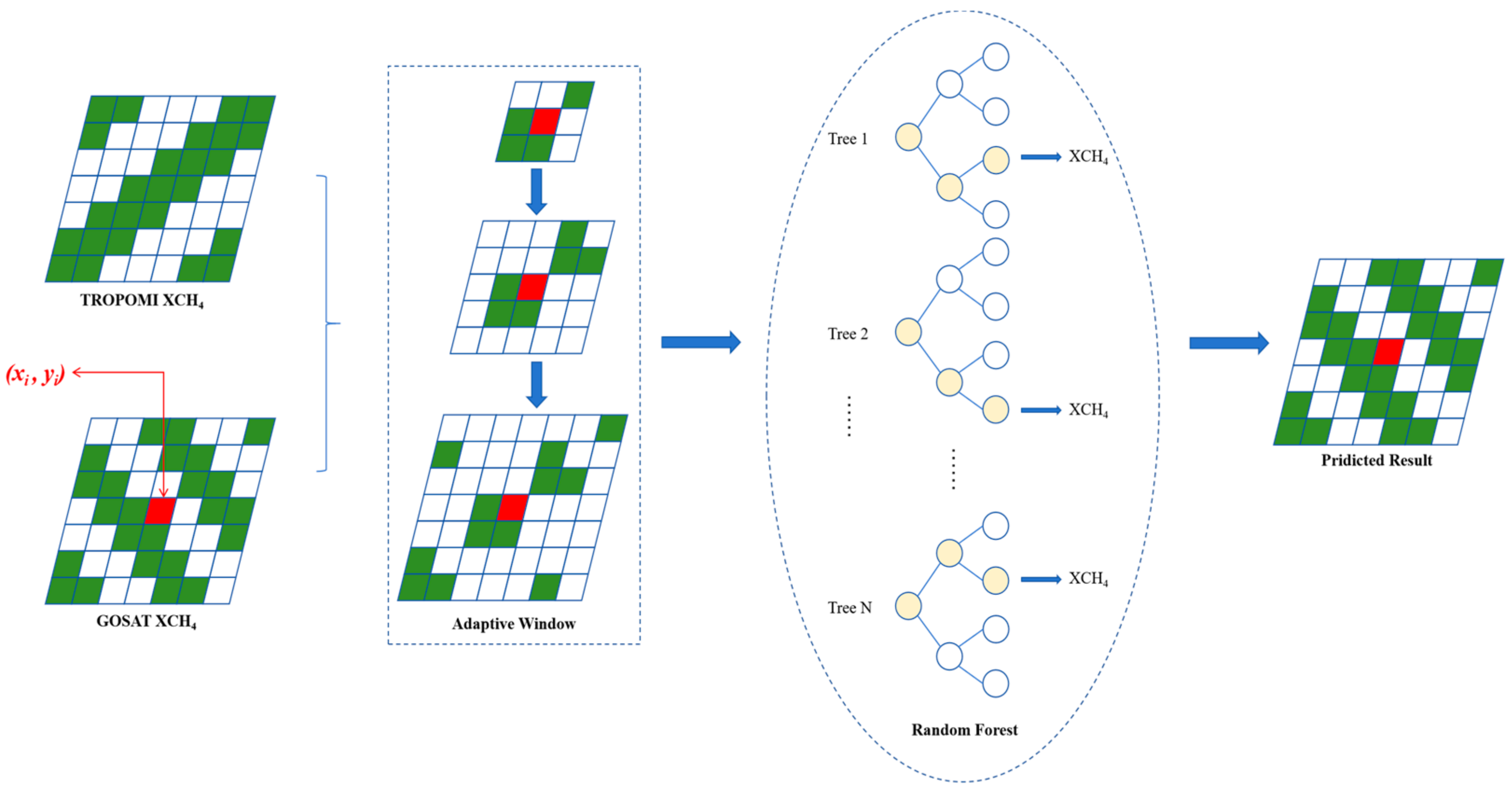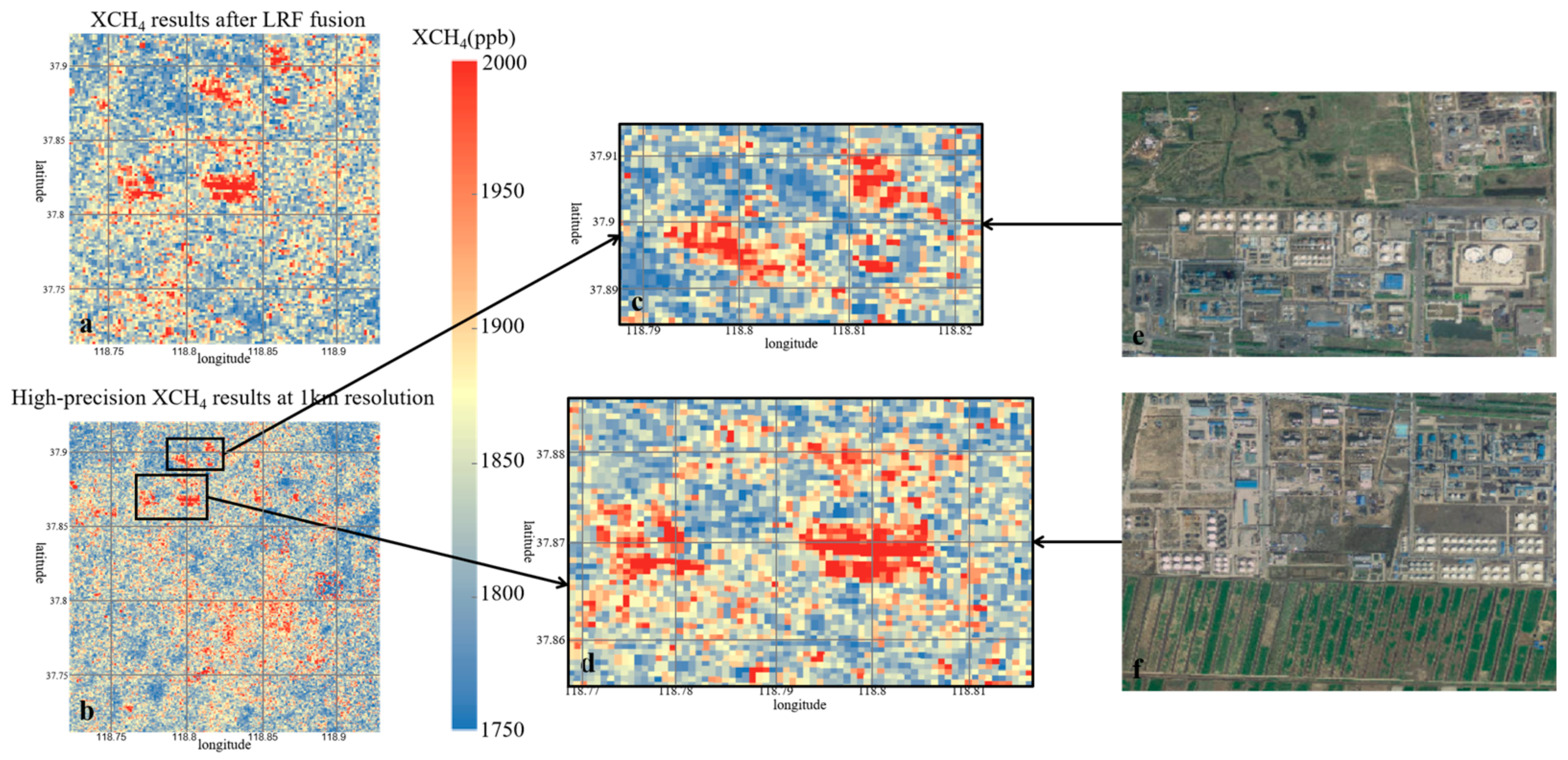Development of a Multi-Source Satellite Fusion Method for XCH4 Product Generation in Oil and Gas Production Areas
Abstract
:1. Introduction
2. Methodology and Data
2.1. Satellite Data
2.1.1. Sentinel-5P Satellite TROPOMI Sensor Data
2.1.2. GOSAT Satellite Data
2.1.3. GF-5 Data
2.2. The Total Carbon Column Observing Network (TCCON) Data
2.3. Overall Technical Approach
2.4. Spatial Matching
2.5. High Precision and Wide Range XCH4 Fusion Dataset Construction
| Algorithm 1. Pseudocode for Fusion Algorithm. |
| Input: |
| - TROPOMI XCH4 dataset TTropomi |
| - GOSAT XCH4 dataset TGosat |
| - Auxiliary variables V(longitude, latitude, aerosol optical depth, surface albedo, DEM, month) |
| - Minimum number of training samples N0 = 100 |
| Output: |
| - Reconstructed high-precision and wide-coverage XCH4 dataset Treconstructed |
| Procedure: |
| For each pixel location (xi,yi) in Ttropomi, do: |
| 1. Initialize spatial window W centered at (xi,yi). |
| 2. Set sample count N = 0. |
| 3. While N < N0, do: |
| a. Expand spatial window W (e.g., increase radius). |
| b. Collect matched samples within W: |
| - S = {(xj,yj) | (xj,yj)∈W, TTropomi(xj,yj) and TGosat(xj,yj) are available}. |
| c. Update sample count.W: |
| 4. End While |
| 5. Prepare training data: |
| a. Dependent variable Y = [TGosat(xj,yj)], ∀(xj,yj)∈S. |
| b. Independent variables X = [ TTropomi(xj,yj), V(xj,yj)], ∀(xj,yj)∈S. |
| 6. Train a random forest model M using X and Y. |
| 7. Predict the XCH4 value at (xi,yi): |
| a. Construct input features xiinput = [TTropomi(xi,yi), V(xi,yi)]. |
| b. Compute predicted value Ŷi = M.predict (xiinput). |
| 8. Assign Ŷi to Trecoustructed(xi,yi). |
| End For |
| Return Trecoustructed. |
2.6. Pre-Processing of GF-5 Data
- A higher hue value (H);
- High saturation (S) due to scattered light mainly originating from shorter wavelength blue-violet light;
- Lower value (V) as sunlight is blocked, reducing brightness.
2.7. Construction of High-Resolution XCH4 Fusion Dataset for Oil Fields
3. Results
3.1. High Precision and Wide Range XCH4 Dataset Fused by GOSAT and TROPOMI Data
3.2. High-Resolution ΔXCH4 Retrieval from GF-5 in the Oil Field Area
3.3. Construction of High-Resolution XCH4 Products for the Oil Field Area and Comparison of High- and Low-Resolution Datasets
4. Discussion
4.1. Strengths and Weaknesses of Each Model
4.2. Challenge and Forward
5. Conclusions
5.1. Data Sources and Data Processing
5.2. Model Development and Performance Evaluation
5.3. High-Resolution Data Processing
5.4. Significance of the Research Results
Author Contributions
Funding
Data Availability Statement
Conflicts of Interest
References
- Denman, K.L. Contribution of working group I to the fourth assessment report of the intergovernmental panel on climate change. In Climate Change 2007: The Physical Science Basis; IPOC: Geneva, Switzerland, 2007; Volume 7. [Google Scholar]
- Han, G.; Huang, Y.; Shi, T.; Zhang, H.; Li, S.; Zhang, H.; Chen, W.; Liu, J.; Gong, W. Quantifying CO2 emissions of power plants with Aerosols and Carbon Dioxide Lidar onboard DQ-1. Remote Sens. Environ. 2024, 313, 114368. [Google Scholar] [CrossRef]
- Saunois, M.; Stavert, A.R.; Poulter, B.; Bousquet, P.; Zhuang, Q. The Global Methane Budget 2000–2017. Earth Syst. Sci. Data 2020, 12, 1561–1623. [Google Scholar] [CrossRef]
- Shindell, D.; Kuylenstierna, J.C.; Vignati, E.; van Dingenen, R.; Amann, M.; Klimont, Z.; Anenberg, S.C.; Muller, N.; Janssens-maenhout, G.; Raes, F.; et al. Simultaneously Mitigating Near-Term Climate Change and Improving Human Health and Food Security. Science 2012, 335, 183–189. [Google Scholar] [CrossRef] [PubMed]
- Lauvaux, T.; Lauvaux, T.; Giron, C.; Mazzolini, M.; d’Aspremont, A.; Duren, R.; Cusworth, D.; Shindell, D.; Ciais, P. Global assessment of oil and gas methane ultra-emitters. Science 2022, 375, 557–561. [Google Scholar] [CrossRef]
- Peng, S.; Lin, X.; Thompson, R.L.; Xi, Y.; Liu, G.; Hauglustaine, D.; Lan, X.; Poulter, B.; Ramonet, M.; Saunois, M.; et al. Wetland emission and atmospheric sink changes explain methane growth in 2020. Nature 2022, 612, 477–482. [Google Scholar] [CrossRef]
- Naus, S.; Maasakkers, J.D.; Gautam, R.; Omara, M.; Stikker, R.; Veenstra, A.K.; Nathan, B.; Irakulis-Loitxate, I.; Guanter, L.; Pandey, S.; et al. Assessing the Relative Importance of Satellite-Detected Methane Superemitters in Quantifying Total Emissions for Oil and Gas Production Areas in Algeria. Environ. Sci. Technol. 2023, 57, 19545–19556. [Google Scholar] [CrossRef]
- Han, G.; Pei, Z.; Shi, T.; Mao, H.; Li, S.; Mao, F.; Ma, X.; Zhang, X.; Gong, W. Unveiling Unprecedented Methane Hotspots in China’s Leading Coal Production Hub: A Satellite Mapping Revelation. Geophys. Res. Lett. 2024, 51, e2024GL109065. [Google Scholar] [CrossRef]
- He, T.-L.; Boyd, R.J.; Varon, D.J.; Turner, A.J. Increased methane emissions from oil and gas following the Soviet Union’s collapse. Proc. Natl. Acad. Sci. USA 2024, 121, e2314600121. [Google Scholar] [CrossRef]
- Chen, Y.L.; Sherwin, E.D.; Berman, E.S.; Jones, B.B.; Gordon, M.P.; Wetherley, E.B.; Kort, E.A.; Brandt, A.R. Quantifying Regional Methane Emissions in the New Mexico Permian Basin with a Comprehensive Aerial Survey. Environ. Sci. Technol. 2022, 56, 4317–4323. [Google Scholar] [CrossRef]
- Irakulis-Loitxate, I.; Guanter, L.; Liu, Y.N.; Varon, D.J.; Maasakkers, J.D.; Zhang, Y.; Chulakadabba, A.; Wofsy, S.C.; Thorpe, A.K.; Duren, R.M.; et al. Satellite-based survey of extreme methane emissions in the Permian basin. Sci. Adv. 2021, 7, eabf4507. [Google Scholar] [CrossRef]
- Varon, D.J.; McKeever, J.; Jervis, D.; Maasakkers, J.D.; Pandey, S.; Houweling, S.; Aben, I.; Scarpelli, T.; Jacob, D. Satellite Discovery of Anomalously Large Methane Point Sources from Oil/Gas Production. Geophys. Res. Lett. 2019, 46, 13507–13516. [Google Scholar] [CrossRef]
- Pei, Z.; Han, G.; Mao, H.; Chen, C.; Shi, T.; Yang, K.; Ma, X.; Gong, W. Improving quantification of methane point source emissions from imaging spectroscopy. Remote Sens. Environ. 2023, 295, 113652. [Google Scholar] [CrossRef]
- Lavoie, T.N.; Shepson, P.B.; Gore, C.A.; Stirm, B.H.; Kaeser, R.; Wulle, B.; Lyon, D.; Rudek, J. Assessing the Methane Emissions from Natural Gas-Fired Power Plants and Oil Refineries. Environ. Sci. Technol. 2017, 51, 3373–3381. [Google Scholar] [CrossRef] [PubMed]
- Cusworth, D.H.; Duren, R.M.; Thorpe, A.K.; Olson-Duvall, W.; Heckler, J.; Chapman, J.W.; Eastwood, M.L.; Helmlinger, M.C.; Green, R.O.; Asner, G.P.; et al. Intermittency of Large Methane Emitters in the Permian Basin. Environ. Sci. Technol. Lett. 2021, 8, 567–573. [Google Scholar] [CrossRef]
- Sherwin, E.D.; Rutherford, J.S.; Zhang, Z.; Chen, Y.; Wetherley, E.B.; Yakovlev, P.V.; Berman, E.S.F.; Jones, B.B.; Cusworth, D.H.; Thorpe, A.K.; et al. US oil and gas system emissions from nearly one million aerial site measurements. Nature 2024, 627, 328–334. [Google Scholar] [CrossRef]
- Williams, J.P.; Omara, M.; Himmelberger, A.; Zavala-Araiza, D.; MacKay, K.; Benmergui, J.; Sargent, M.; Wofsy, S.C.; Hamburg, S.P.; Gautam, R. Small emission sources disproportionately account for a large majority of total methane emissions from the US oil and gas sector. EGUsphere 2024, 2024, 1–31. [Google Scholar] [CrossRef]
- Wu, D.; Yue, Y.; Jing, J.; Liang, M.; Sun, W.; Han, G.; Lou, M. Background Characteristics and Influence Analysis of Greenhouse Gases at Jinsha Atmospheric Background Station in China. Atmosphere 2023, 14, 1541. [Google Scholar] [CrossRef]
- Jacob, D.J.; Varon, D.J.; Cusworth, D.H.; Dennison, P.E.; Frankenberg, C.; Gautam, R.; Guanter, L.; Kelley, J.; McKeever, J.; Ott, L.E.; et al. Quantifying methane emissions from the global scale down to point sources using satellite observations of atmospheric methane. Atmos. Chem. Phys. 2022, 22, 9617–9646. [Google Scholar] [CrossRef]
- Zhang, Y.; Gautam, R.; Pandey, S.; Omara, M.; Maasakkers, J.D.; Sadavarte, P.; Lyon, D.; Nesser, H.; Sulprizio, M.P.; Varon, D.J.; et al. Quantifying methane emissions from the largest oil-producing basin in the United States from space. Sci. Adv. 2020, 6, eaaz5120. [Google Scholar] [CrossRef]
- Pei, Z.P.; Han, G.; Ma, X.; Shi, T.Q.; Gong, W. A Method for Estimating the Background Column Concentration of CO2 Using the Lagrangian Approach. IEEE Trans. Geosci. Remote Sens. 2022, 60, 4108112. [Google Scholar] [CrossRef]
- Zhang, J.; Han, G.; Mao, H.; Pei, Z.; Ma, X.; Jia, W.; Gong, W. The Spatial and Temporal Distribution Patterns of XCH4 in China: New Observations from TROPOMI. Atmosphere 2022, 13, 177. [Google Scholar] [CrossRef]
- Song, H.; Sheng, M.; Lei, L.; Guo, K.; Zhang, S.; Ji, Z. Spatial and Temporal Variations of Atmospheric CH4 in Monsoon Asia Detected by Satellite Observations of GOSAT and TROPOMI. Remote Sens. 2023, 15, 3389. [Google Scholar] [CrossRef]
- Huang, Y.Y.; Han, G.; Shi, T.Q.; Li, S.W.; Mao, H.Q.; Nie, Y.H.; Gong, W. FI-SCAPE: A Divergence Theorem Based Emission Quantification Model for Air/Space-Borne Imaging Spectrometer Derived XCH4 Observations. IEEE J. Sel. Top. Appl. Earth Obs. Remote Sens. 2024. [CrossRef]
- Breiman, L. Random forests. Mach. Learn. 2001, 45, 5–32. [Google Scholar] [CrossRef]
- Kump, L.R. What drives climate? Nature 2000, 408, 651–652. [Google Scholar] [CrossRef]
- Glumb, R.; Davis, G.; Lietzke, C. The TANSO-FTS-2 instrument for the GOSAT-2 greenhouse gas monitoring mission. In Proceedings of the 2014 IEEE Geoscience and Remote Sensing Symposium, Quebec City, QC, Canada, 13–18 July 2014; IEEE: New York, NY, USA, 2014; pp. 1238–1240. [Google Scholar]
- Varon, D.J.; Jacob, D.J.; Hmiel, B.; Gautam, R.; Lyon, D.R.; Omara, M.; Sulprizio, M.; Shen, L.; Pendergrass, D.; Nesser, H.; et al. Continuous weekly monitoring of methane emissions from the Permian Basin by inversion of TROPOMI satellite observations. Atmos. Chem. Phys. Discuss. 2022, 23, 7503. [Google Scholar] [CrossRef]
- Plant, G.; Kort, E.A.; Murray, L.T.; Maasakkers, J.D.; Aben, I. Evaluating urban methane emissions from space using TROPOMI methane and carbon monoxide observations. Remote Sens. Environ. 2022, 268, 112756. [Google Scholar] [CrossRef]
- Schneising, O.; Buchwitz, M.; Reuter, M.; Vanselow, S.; Bovensmann, H.; Burrows, J.P. Remote sensing of methane leakage from natural gas and petroleum systems revisited. Atmos. Chem. Phys. 2020, 20, 9169–9182. [Google Scholar] [CrossRef]
- Li, K.; Bai, K.; Jiao, P.; Chen, H.; He, H.; Shao, L.; Sun, Y.; Zheng, Z.; Li, R.; Chang, N.B. Developing unbiased estimation of atmospheric methane via machine learning and multiobjective programming based on TROPOMI and GOSAT data. Remote Sens. Environ. 2024, 304, 114039. [Google Scholar] [CrossRef]
- Yang, J.; Gan, R.; Luo, B.; Wang, A.; Shi, S.; Du, L. An Improved Method for Individual Tree Segmentation in Complex Urban Scene Based on Using Multispectral LiDAR by Deep Learning. IEEE J. Sel. Top. Appl. Earth Obs. Remote Sens. 2024, 17, 6561–6576. [Google Scholar] [CrossRef]
- Wang, Y.; Yuan, Q.; Li, T.; Yang, Y.; Zhou, S.; Zhang, L. Seamless mapping of long-term (2010–2020) daily global XCO2 and XCH4 from the Greenhouse Gases Observing Satellite (GOSAT), Orbiting Carbon Observatory 2 (OCO-2), and CAMS global greenhouse gas reanalysis (CAMS-EGG4) with a spatiotemporally self-supervised fusion method. Earth Syst. Sci. Data 2023, 15, 3597–3622. [Google Scholar]
- Qiu, R.; Han, G.; Li, X.; Xiao, J.; Liu, J.; Wang, S.; Li, S.; Gong, W. Contrasting responses of relationship between solar-induced fluorescence and gross primary production to drought across aridity gradients. Remote Sens. Environ. 2024, 302, 113984. [Google Scholar] [CrossRef]
- Xu, M.; Han, G.; Pei, Z.; Yu, H.; Li, S.; Gong, W. Advanced method for compiling a high-resolution gridded anthropogenic CO2 emission inventory at a regional scale. Geo-Spat. Inf. Sci. 2024, 1–14. [Google Scholar]
- Liu, B.; Ma, X.; Guo, J.; Wen, R.; Li, H.; Jin, S.; Ma, Y.; Guo, X.; Gong, W. Extending the wind profile beyond the surface layer by combining physical and machine learning approaches. Atmos. Chem. Phys. 2024, 24, 4047–4063. [Google Scholar] [CrossRef]
- Liang, A.; Pang, R.; Chen, C.; Xiang, C. XCO2 Fusion Algorithm Based on Multi-Source Greenhouse Gas Satellites and CarbonTracker. Atmosphere 2023, 14, 1335. [Google Scholar] [CrossRef]
- Shi, T.; Han, G.; Ma, X.; Pei, Z.; Chen, W.; Liu, J.; Zhang, X.; Li, S.; Gong, W. Quantifying strong point sources emissions of CO2 using spaceborne LiDAR: Method development and potential analysis. Energy Convers. Manag. 2023, 292, 117346. [Google Scholar] [CrossRef]
- He, J.; Wang, W.; Fu, M.; Wang, Y. Insights into global visibility patterns: Spatiotemporal distributions revealed by satellite remote sensing. J. Clean. Prod. 2024, 468, 143069. [Google Scholar] [CrossRef]
- Cai, M.; Han, G.; Ma, X.; Pei, Z.; Gong, W. Active–passive collaborative approach for XCO2 retrieval using spaceborne sensors. Opt. Lett. 2022, 47, 4211–4214. [Google Scholar] [CrossRef]
- Zhang, H.; Han, G.; Chen, W.; Pei, Z.; Liu, B.; Liu, J.; Zhang, T.; Li, S.; Gong, W. Validation Method for Spaceborne IPDA LIDAR XCO2 Products via TCCON. IEEE J. Sel. Top. Appl. Earth Obs. Remote Sens. 2024, 17, 16984–16992. [Google Scholar] [CrossRef]
- Wang, L.; Yang, L.; Wang, Y. Analysis of China’s Oil and Gas Industrial Green and Low-carbon Development Strategies and Paths in New Era. Pet. Sci. Technol. Forum 2022, 42, 67. [Google Scholar]
- Liang, A.; Gong, W.; Han, G.; Xiang, C. Comparison of Satellite-Observed XCO2 from GOSAT, OCO-2, and Ground-Based TCCON. Remote Sens. 2017, 9, 1033. [Google Scholar] [CrossRef]
- Pei, Z.; Han, G.; Shi, T.; Ma, X.; Gong, W. A XCO2 Retrieval Algorithm Coupled Spatial Correlation for the Aerosol and Carbon Detection Lidar. Atmos. Environ. 2023, 309, 119933. [Google Scholar] [CrossRef]
- Shi, T.Q.; Han, G.; Ma, X.; Gong, W.; Chen, W.; Liu, J.; Zhang, X.; Pei, Z.; Gou, H.; Bu, L. Quantifying CO2 Uptakes Over Oceans Using LIDAR: A Tentative Experiment in Bohai Bay. Geophys. Res. Lett. 2021, 48, e2020GL091160. [Google Scholar] [CrossRef]
- Qiu, R.; Li, X.; Han, G.; Xiao, J.; Ma, X.; Gong, W. Monitoring drought impacts on crop productivity of the US Midwest with solar-induced fluorescence: GOSIF outperforms GOME-2 SIF and MODIS NDVI, EVI, and NIRv. Agric. For. Meteorol. 2022, 323, 109038. [Google Scholar] [CrossRef]
- Pei, Z.; Han, G.; Ma, X.; Su, H.; Gong, W. Response of major air pollutants to COVID-19 lockdowns in China. Sci. Total Environ. 2020, 743, 140879. [Google Scholar] [CrossRef] [PubMed]
- Zhang, H.; Han, G.; Ma, X.; Chen, W.; Zhang, X.; Liu, J.; Gong, W. Robust algorithm for precise X CO2 retrieval using single observation of IPDA LIDAR. Opt. Express 2023, 31, 11846–11863. [Google Scholar] [CrossRef]
- Lorente, A.; Borsdorff, T.; Butz, A.; Hasekamp, O.; Aan De Brugh, J.; Schneider, A.; Wu, L.; Hase, F.; Kivi, R.; Wunch, D.; et al. Methane retrieved from TROPOMI: Improvement of the data product and validation of the first 2 years of measurements. Atmos. Meas. Tech. 2021, 14, 665–684. [Google Scholar] [CrossRef]
- Ying, J.; Jiang, J.; Wang, H.; Liu, Y.; Gong, W.; Liu, B.; Han, G. Analysis of the Income Enhancement Potential of the Terrestrial Carbon Sink in China Based on Remotely Sensed Data. Remote Sens. 2023, 15, 3849. [Google Scholar] [CrossRef]
- Yi, J.; Huang, Y.; Pei, Z.; Han, G. Urban Area Observing System (UAOS) Simulation Experiment Using DQ-1 Total Column Concentration Observations. EGUsphere 2024, 2024, 1–40. [Google Scholar]









| Satellite | Spatial Resolution | Revisit Period | Overpass Time | Orbit Altitude | Launch Date |
|---|---|---|---|---|---|
| Sentinel-5P | 7 km × 7 km | daily | 13:30 | 824 km | 2017.10 |
| GOSAT | 10.5 km diameter | 3 days | 13:00 | 666 km | 2009.01 |
| GF-5 | 30 m | 2 days | 10:30 | 705 km | 2018.05 |
| Data Source | RMSE |
|---|---|
| TROPOMI data before fusion | 43.409 ppb |
| Data fitted by linear regression model | 35.024 ppb |
| Data fitted by random forest model | 29.118 ppb |
| Data fitted by local random forest model | 23.201 ppb |
Disclaimer/Publisher’s Note: The statements, opinions and data contained in all publications are solely those of the individual author(s) and contributor(s) and not of MDPI and/or the editor(s). MDPI and/or the editor(s) disclaim responsibility for any injury to people or property resulting from any ideas, methods, instructions or products referred to in the content. |
© 2024 by the authors. Licensee MDPI, Basel, Switzerland. This article is an open access article distributed under the terms and conditions of the Creative Commons Attribution (CC BY) license (https://creativecommons.org/licenses/by/4.0/).
Share and Cite
Fan, L.; Wan, Y.; Dai, Y. Development of a Multi-Source Satellite Fusion Method for XCH4 Product Generation in Oil and Gas Production Areas. Appl. Sci. 2024, 14, 11100. https://doi.org/10.3390/app142311100
Fan L, Wan Y, Dai Y. Development of a Multi-Source Satellite Fusion Method for XCH4 Product Generation in Oil and Gas Production Areas. Applied Sciences. 2024; 14(23):11100. https://doi.org/10.3390/app142311100
Chicago/Turabian StyleFan, Lu, Yong Wan, and Yongshou Dai. 2024. "Development of a Multi-Source Satellite Fusion Method for XCH4 Product Generation in Oil and Gas Production Areas" Applied Sciences 14, no. 23: 11100. https://doi.org/10.3390/app142311100
APA StyleFan, L., Wan, Y., & Dai, Y. (2024). Development of a Multi-Source Satellite Fusion Method for XCH4 Product Generation in Oil and Gas Production Areas. Applied Sciences, 14(23), 11100. https://doi.org/10.3390/app142311100







